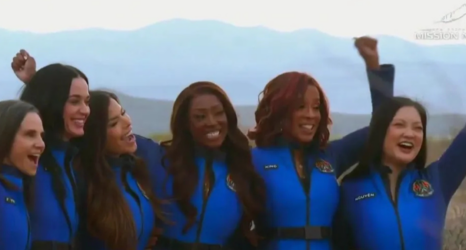Rounded bodies blending into the lines, curves and edges of desolate terrains. A family of four, each in calavera makeup, sitting around a suburban living room. Lesbian women embracing. Laura Aguilar’s photography often portrayed her subjects frankly—but with a certain kind of tenderness, unwilling to surrender to society’s judgement of marginalized people.
After decades of exploring identities through her art, including her own, the photographer died on April 25. She was 58.
Lesbian, Latina and large-bodied, Aguilar recently regained attention with her September 2017 exhibition “Show and Tell” in which she reclaimed her body and her life journey. The exhibition marks the first comprehensive retrospective of the American photographer, assembling over 100 photographs and videos from Aguilar’s three decades of work in her native Los Angeles. The show, after opening at the Vincent Price Art Museum, is currently in its East Coast premiere at the Patricia & Phillip Frost Art Museum FIU in Miami until June 3.
Born in San Gabriel, Calif., in 1959 to a Mexican-American father and a Mexican-Irish mother, Aguilar grew up struggling with depression and auditory dyslexia, which made it hard for her to communicate, even verbally. She turned to photography as a teenager and was largely self-taught until she took several classes at East Los Angeles College. As Aguilar continued to explore the art form, she immersed herself in the Chicanx and Latinx art communities in eastside Los Angeles—and it was there she found inspiration for many of her photos.
Through portraits of the women of the Plush Pony, the bar popular among lesbians of color in eastside Los Angeles, to images of the working-class, queer, disabled and people of color alternatively clothed and unclothed, Aguilar’s photographs rebel against repressive stereotypes of beauty and body representation. “Laura’s work highlighted the beauty of underrepresented communities,” Florida artist Shoog McDaniel told The Lily. “The portraiture she did of Chicanx lesbians in the ’80s is stunning, and so important, because who else was taking photos and recording these histories then?”
In her own self-portraits, Aguilar explores her struggles with depression, obesity, self-acceptance, prejudice and misogyny. In both the “Grounded” and “Nature Self-Portrait” photo series, she integrates her naked body with the rocky terrains of a desert landscape. As the photographer explained in her “Show and Tell” artist statement: “I’m trying to convince myself I’m not what I always thought of myself: ‘I’m ugly, I’m fat, I’m not worth living.’ I am these things too: I am a kind person, a funny person, a compassionate person. In the photographs I’m beautiful. I’m kind to myself.”
In “Three Eagles Flying,” a photo in which the artist is bound by thick rope, and partially covered and flanked by Mexican and American flags, Aguilar, for instance, explores the intersection and conflicts of her own racial, gendered, cultural and sexual identities. “This is a deeply personal piece,” Sybil Venegas, the curator for “Show and Tell,” wrote in a piece for KCET, “drawing upon conflicting emotions Aguilar experienced as a child when she lacked the ability to verbally express reactions to her family dynamics, her relationship with her mother, the loss of her grandmother, her skin color, her body weight, her limited language abilities in English and lack of Spanish and the challenges of navigating her racial and cultural identity, as Mexican, Mexican American and American.”
As bold as her work was, Aguilar didn’t originally intend to create such overtly political work. Aguilar even described her images as “the playfulness of being creative.” And yet because of the communities through which she navigated, as well as her own identities and struggles, Aguilar’s work was regarded as inherently political. “What she was doing was decades ahead of its time, especially if you look at race, if you look at the history of landscape photography, if you look at the male gaze, if you look at the body and its relationship to nature and its particular connection to the American West,” curator Susanne Vielmetter said. “It was all about photography and the gaze. She was both the subject and the object. She was both the photographer and the mood.”
Aguilar’s profound work, however, didn’t gain as much widespread recognition until recently, when the Vincent Price Art Museum featured “Show and Tell” as part of the Getty Foundation’s Pacific Standard Time: LA/LA, the art initiative in the fall of 2017 that explored Latinx and Latin American art across Los Angeles. The exhibition opened to much acclaim and was routinely highlighted as one of the best shows in the Pacific Standard Time initiative—which featured over 70 exhibitions.
Even though the photographer was decades before her time, thanks in part to the now-touring exhibition of “Show and Tell,” Aguilar and her pioneering photography will continue to jar and resonate with viewers across the country. “She leaves a legacy of vulnerability and honesty for [the] next generation artist,” explained Melba Martinez, a Los Angeles-based community organizer and artist. “Her art is a way of healing for both her and the audience and I know that her work will continue to heal many queer, POC, fat folks for generations to come.”





